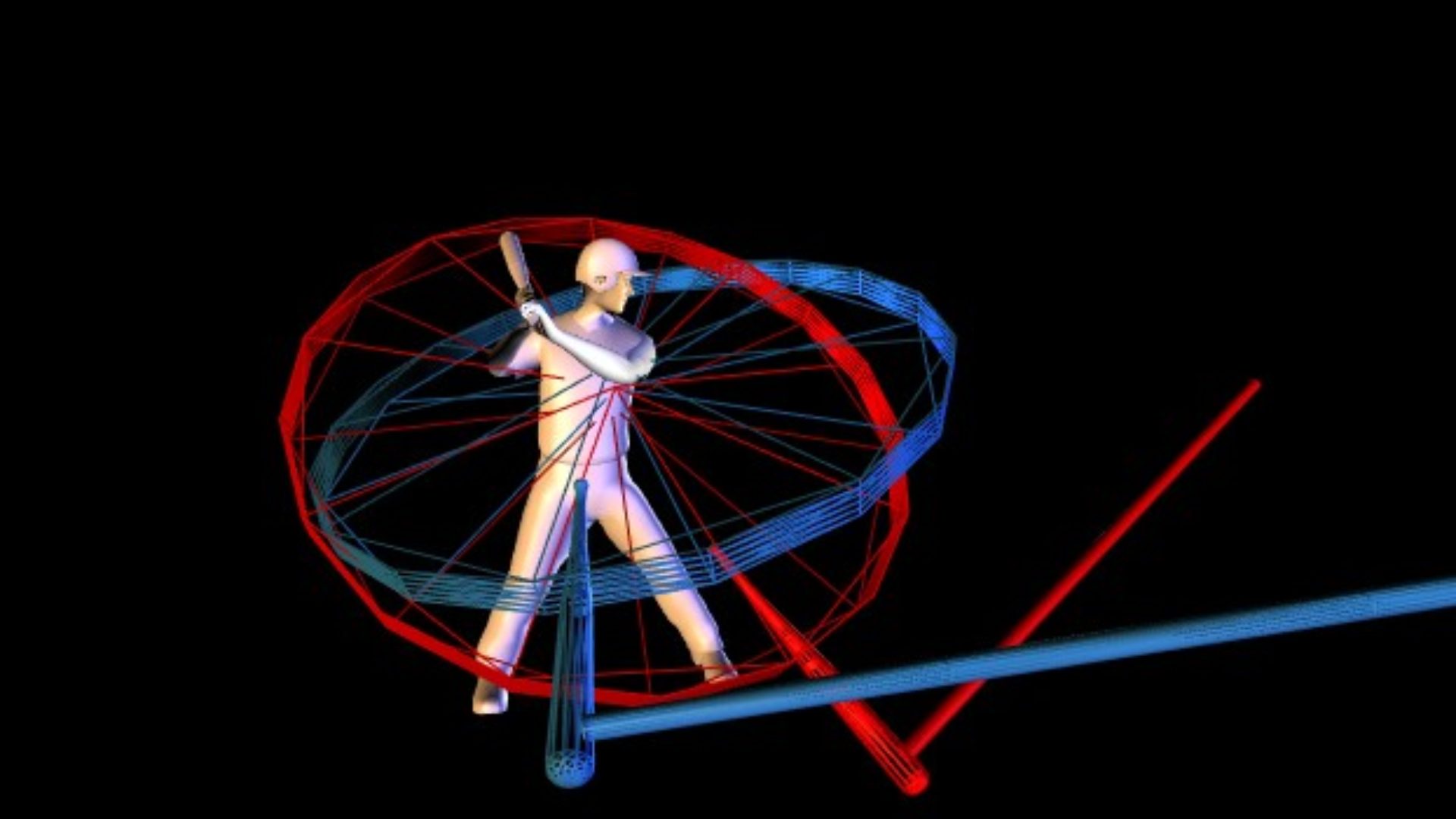The ‘early connection’ metric has been adopted by many players, coaches, and organizations within the baseball and softball industries. It has been popularized by Blast Motion which includes this bat-to-torso metric in their sensor with a target range of 80 to 105 degrees. Since the results of this research are contrary to what is in the Blast Motion sensor, we provided them with an advance copy of the research and invited them to comment but we had not received a response by the time of publishing.
As many of you know, our mission is to search for opportunities where the hitting establishment and consensus views are not in line with the data and what the best hitters are actually doing. We have identified several popular views that don’t hold up to the data including hitting with backspin, keeping the barrel in the zone, and several others discussed in Quantitative Hitting. In all of this, our goal is to help improve the player development and player evaluation processes – not criticize any particular individual or organization.
The following data comes from the Driveline OpenBiomechanics Project and we would like to thank Kyle Wasserberger and the Driveline team for making this data available for public use. I can’t emphasize the value of this project enough. So many of the debates within baseball regarding hitting mechanics, coaching philosophies, drills, etc. can be answered using the data from this project.
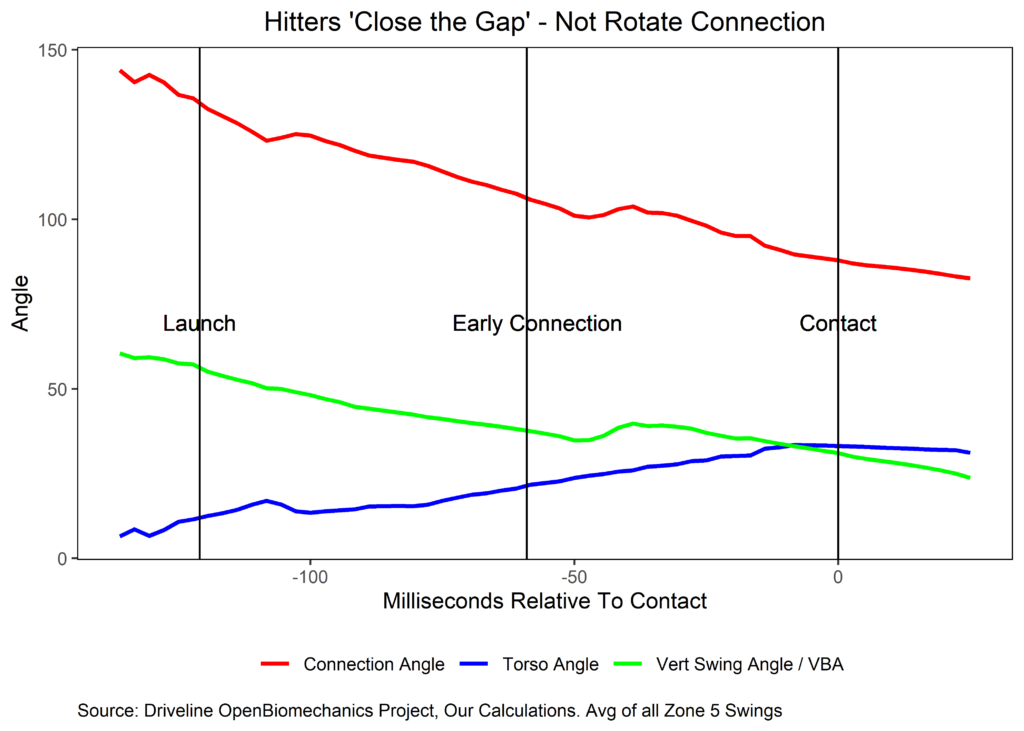
Note on calculations above: The OpenBiomechanics project provides the early connection values directly. We calculated bat-torso angles at other points in time based on information contained in the project. One particular point to note is that the slight uptick in VBA at -50 ms may not be caused by an actual steepening of the swing plane. In other words, at some points in the swing the vertical angle of the bat is not representative of the vertical angle of the swing. Although we attempted to address this through various different methods, none of them were entirely satisfactory.
In a nutshell, what we find in the data is that there is really no such thing as ‘early connection’ (EC) – rather, what is actually happening is that there is a bat-torso connection gap that is created earlier in the swing which continues through the point of EC. This bat-torso connection gap is closed through one-directional adjustments of the bat and torso angles – in opposite directions which get hitters to approximate connection around the time of contact.
The short amount of time spent at connection really sticks out. Connection is occurring for approximately one frame (at 360 fps) – so approximately 2.8 milliseconds – with the swing continuing further away from connection after contact.
3D illustration
Before we dig into the data, let’s take a look at a 3D illustration of what happens in a ‘typical’ high-level baseball swing. The player below is a MiLB hitter on a middle/middle pitch location.
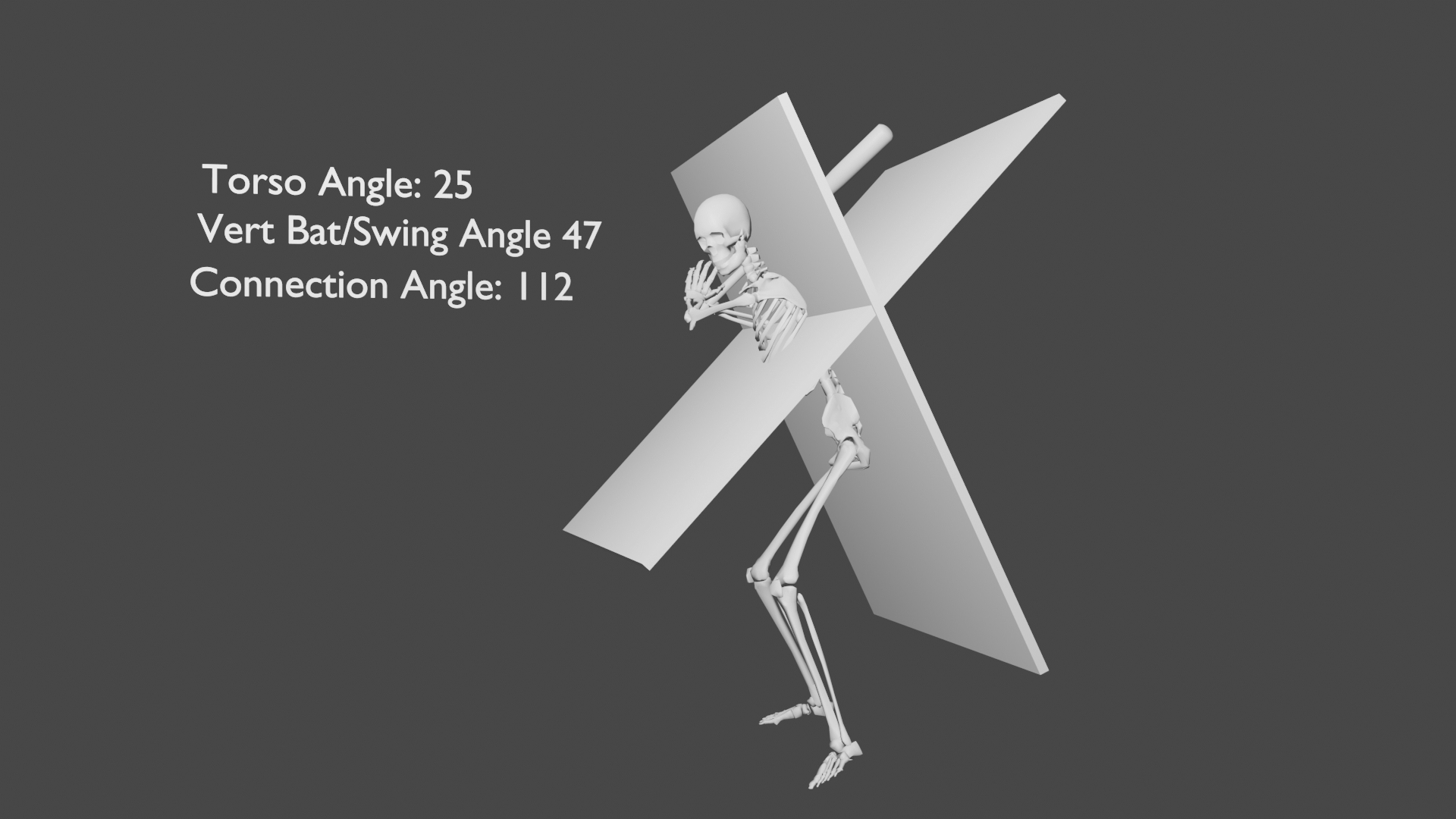
The above 3D illustration provides a good visual of what is happening in terms of the bat and body changes during the swing. What is very noticeable is the increased lateral torso flexion after the launch phase of the swing. So while the forward bend ‘converts’ to side bend, there is additional shoulder tilt between EC and contact that increases rapidly.
Biomechanical Bat and Body Data

We find that the average ‘early connection’ (EC) angle is 109 – a whopping 19 degrees away from the 90 degree target that many are using as optimal. As shown above, a 90 degree EC would place a player in the lowest quintile. In reality, players create a bat-torso gap during the launch phase of the swing and that gap is closed through opposing adjustments (bat flatter, increased torso flexion) as they approach contact. On average, this gap is closed in a mix of approximately 60/40, bat/body adjustment, respectively. This is an average mix which changes based on the pitch location. Lower and inside pitches have relatively more body adjustment and higher and outside pitches have relatively more bat adjustment. Since the number of balls thrown in some of the outer zones was fairly limited in the Driveline project, we chose not to do a breakout of bat and body angles by zone.
On average, EC is occurring 57 ms before contact. This means the EC gap of 19 degrees is being closed at a rate of approximately 333 degrees per second from both the bat and body. While this isn’t lightning fast, it shows a much different picture than a hitter maintaining/rotating a connected angle.
The data above gives us a framework to understand what is happening with the bat and body angles. In other words, if there is connection at contact and one directional adjustment in opposite directions between EC and contact, then there can’t possibly also be ‘early connection’. The only way for all three conditions to hold (EC, bat and body adjustment, and connection at contact) would be for the bat and body to adjust in the same direction – which is clearly not the case based on the data. Given this framework, it would stand to reason that once a swing becomes ‘connected’, it is no longer adjustable. In other words for a swing to stay connected, either the bat or body would have to move contrary to the adjustment framework clearly evident in the data.
This finding – that there is no EC in a baseball swing is very similar to other mechanics ‘surprises’ where an unexpected factor (i.e., the one-directional adjustment framework) trumps other expected factors that are in full view. Although the ‘why’ there is no EC is less important at this early stage, our guess would be that it is because either 1) One directional adjustments are more efficient given the time constraint imposed by the pitcher and/or 2) Bat flattening and increased torso flexion are much more natural adjustment directions. Regardless of the exact reason, hitters are clearly prioritizing adjustment over connection.
Consistency with MLB Data
We have obtained vertical bat angles for major league hitters through a computer vision algorithm. We currently have these angles at approximately 83 ms before contact (which we are calling Vertical Entry Angles or VEA). We also have several years of data for VBA at contact. If we compare the hitters in the Driveline study to MLB hitters – both at 83 ms before contact, we find they are somewhat similar in terms of the angles.
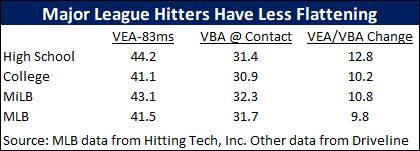
One interesting data point to note is that MLB hitters have slightly less VEA/VBA change. As you will note in the second set of charts below – it just so happens that hitters with less than 10 degrees of change have better contact quality and overall performance. It is very possible that lower level players could possibly improve their performance by reducing their amount of flattening. The following charts are all based on our data overlaid with the batted ball data from baseballsavant as well as performance summary data from Fangraphs.
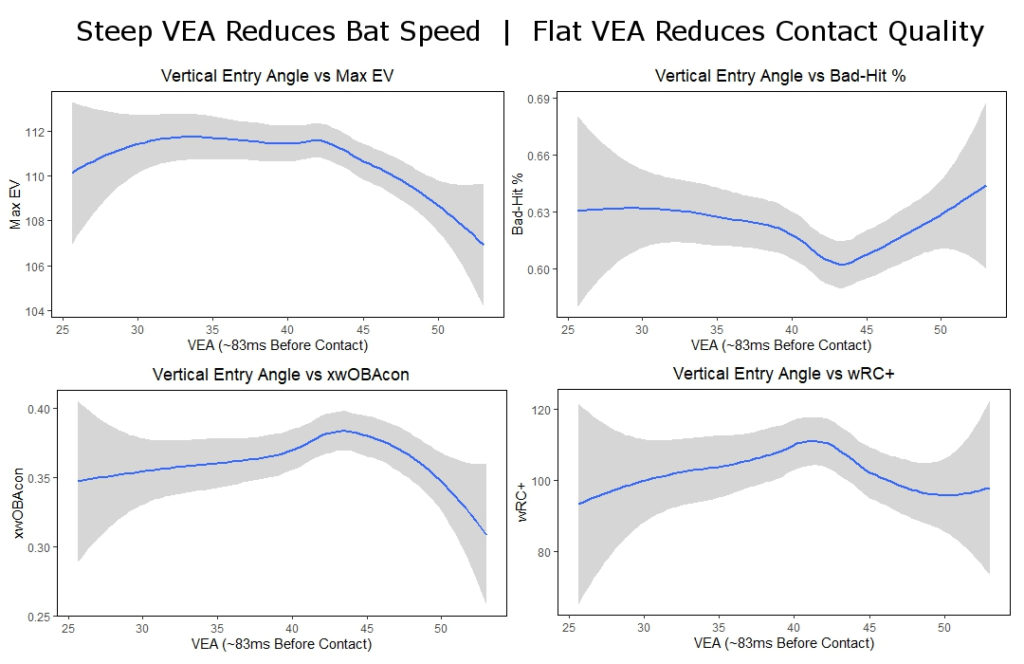
Although we don’t have torso angles on the MLB side, we do see similar bat flattening patterns around the time of EC into bat-ball contact. One particular performance takeaway between our data and the Driveline data is that it appears the lower level players could possibly get a performance boost by flattening less. As shown in the MLB data below, players with VEA/VBA flattening slightly less than 10 degrees experience better overall performance.
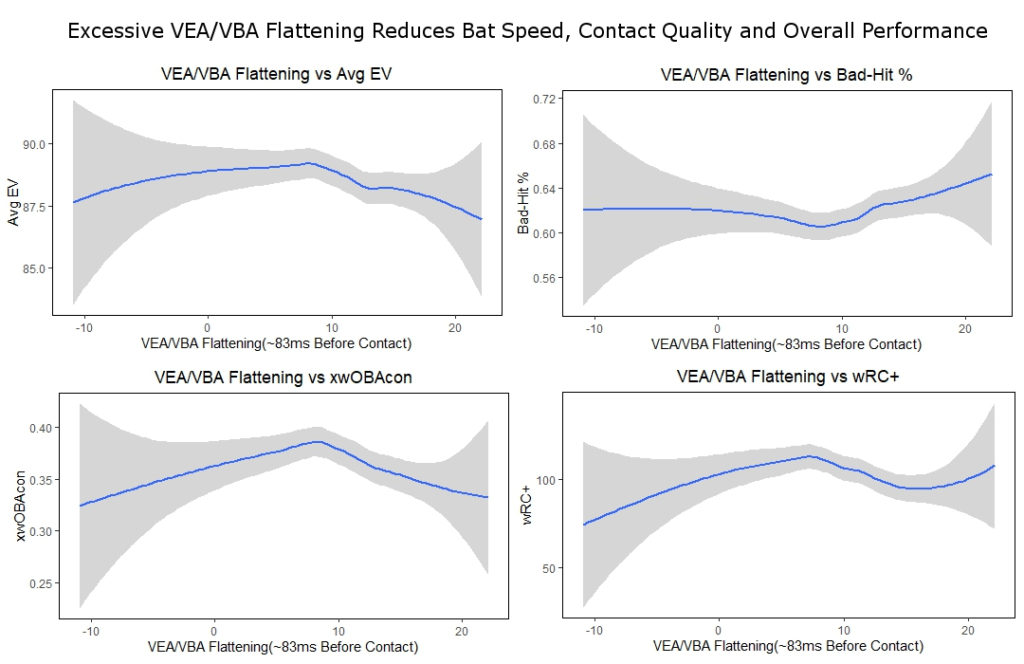
Implications for ‘On-Plane Efficiency’
Both our MLB proprietary bat angle data as well as the Driveline data suggest that maximizing on-plane efficiency is not performance enhancing. Since on-plane efficiency is maximized when the VBA/VEA at the time of EC is equal to the VBA at contact, it is clear from the MLB charts above that zero flattening is sub-optimal in terms of contact quality and overall performance. Too much VBA flattening also has a negative impact on performance as this reduces EV, contact quality and overall performance. In our view, there are two important takeaways from the data. First, a certain amount of both bat and torso angle change between EC and contact would appear to increase overall performance. Second, the MLB data shows less flattening relative to the lower levels of play (-9 for MLB vs. -12.5 for the lower levels) captured in the Driveline data suggesting amateur players may benefit from less VBA flattening between EC and contact. Based on the data, it seems ill-advised to recommend stable bat and torso angles between EC and contact.
Symptoms of a Larger Industry Problem
Since many of these ‘obvious’ desirable swing mechanics continue to get trumped by less considered, but more important factors, we believe it is important to step back and ask why this is happening so often. In our view, what is happening is that there is a strong desire to simplify the complexity for hitters. It’s not that simplification is necessarily bad, it’s just that it is occurring too early in the metric (or idea) development process. In other words, in many cases, the process starts with some ‘obvious’ surface-level logic. Let’s take ‘keeping the barrel in the zone’ as an example. Initially, it’s hard to understand why this wouldn’t enhance performance. The reason why this doesn’t work is that swings with higher average attack angles and VBA perform better due to increased contact quality – but the barrel is ‘in the zone’ for a much shorter period of time. So while contact rates do improve, overall performance is reduced as contact quality trumps ‘time in the zone’.
In our view, we would be much better served by changing the process – much more questioning and examining before offering up an idea or metric that may take many hitters down the wrong path. Take math for example. The process is solve, then simplify. With hitting, it is very difficult to understand all the relevant factors without data. While this is challenging in some instances as complete biomechanical data mapped to batted ball results is not available, we/the industry are not even using the data and technology we do have. In our view, we should not just now be learning about the bat/body adjustability framework and that it trumps anything to do with ‘connection’.
Summary & Recommendation
The evidence is overwhelming that hitters aren’t connecting early and maintaining bat and torso angles into contact. As discussed above, there can’t be ‘early connection’, adjustment, and connection at contact given that bat/torso adjustments are in opposite directions. All three conditions can’t be true. Unfortunately, there are likely hitters who made swing changes based on what they believed to be true which took them in a wrong direction. Even more unfortunate, in our view, is that this is only one of many metrics/ideas that don’t hold up to the data which indicate a more systematic problem within the industry. Practitioners have been training based on biomechanical data for several years now (K-Vest, 4D Motion, etc.). In our view, we should not be discovering the bat/body adjustment framework and the lack of connection in a swing in 2023. We postulated that there was no ‘early connection’ in a Twitter post in December 2019 but didn’t have the data to prove it out at the tme.
On the positive side, the MLB data suggests there may be performance enhancing ranges for both bat and body angles and change that may be more helpful to hitters. We would strongly encourage hitters to be very selective regarding the metrics they are using in their training – asking the question of: Has a particular metric been proven out based on in-game batted ball data? If not, there may be unforeseen factors that come into play that influence a metric’s relationship to performance. It doesn’t mean all the untested metrics (to batted ball data) are bad – just that there is a larger probability for a surprise. As we discuss in Quantitative Hitting, the ‘hitter brain’ seems to be much smarter than we/the industry give it credit for. I wonder what else it knows that we don’t.
